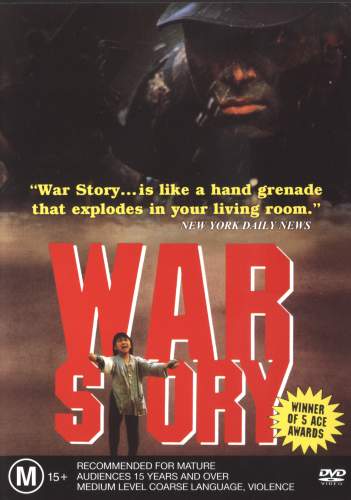War Story (Vietnam War Story) (1987) |
|
War Story (Vietnam War Story) (1987) |
|


|
| BUY IT |
| General | Extras | ||
| Category | War | None | |
| Rating |

|
||
| Year Of Production | 1987 | ||
| Running Time | 93:55 (Case: 87) | ||
| RSDL / Flipper | No/No | Cast & Crew | |
| Start Up | Menu | ||
| Region Coding | 1,2,3,4,5,6 | Directed By |
Todd Holland Michael Toshiyuki Uno |
|
Studio
Distributor |
 Warner Vision |
Starring |
Todd Graff Raymond Cruz Glenn Morshower |
| Case | Amaray-Transparent-Secure Clip | ||
| RPI | $19.95 | Music | Christopher Young |
| Video | Audio | ||
| Pan & Scan/Full Frame | Full Frame | English Dolby Digital 2.0 (224Kb/s) | |
| Widescreen Aspect Ratio | None | ||
| 16x9 Enhancement | No | ||
| Video Format | 576i (PAL) | ||
| Original Aspect Ratio | 1.33:1 | Miscellaneous | |
| Jacket Pictures | No | ||
| Subtitles | None | Smoking | Yes |
| Annoying Product Placement | No | ||
| Action In or After Credits | No | ||
If you're like me, there has only ever really been one film about the Vietnam War, and that was Francis Ford Coppola's masterpiece Apocalypse Now. Perhaps the reason I found that film so utterly compelling, and aspects of Platoon and the recent Mel Gibson vehicle, We Were Soldiers, somewhat overwrought and heavy-handed is that Coppola's film is about the Vietnam War without being about the Vietnam War. Its true power is derived from the same place as that of the works of the great Joseph Conrad, Heart of Darkness being a well publicised source of inspiration for the film: the mysterious and unrelenting darkness that does indeed reside in the human soul. Apocalypse Now is both a more primitive and more sophisticated film than either of the two mentioned - it attempts more rudimentary, and by turns, greater things. In dealing with the essence of the 'human condition', as another great author, William Golding wrote, it artfully avoids the pitfalls of placing histrionic emphasis on the realities of historical events not far removed from many people's memories.
I preface my review of War Story, a collection of three documentary style short films about the experiences of American soldiers during the times of the Vietnam War, with what I have written because as I watched I constantly felt that however brutally compelling the stories seemed, the very act of telling them without anything of an emotional context rendered them somewhat moot. Anyway I have digressed a little too far I think. As they are, the three episodes, each roughly 30 minutes in length, are interesting and provide some insights into 'first hand' experience - if one can ever hope to glean such a thing from a film dealing with war, let alone Vietnam.
The first, An Old Ghost Walks the Earth (28:35), takes place in a village in Vietnam where American soldiers have been stationed. One idealistic soldier (Tim Guinee) wants to "make a difference" and seeks out approval to organise the restoration of farming in the area, to help the local villagers. Wesley Snipes in one of his earliest roles plays a seemingly dispassionate soldier who warns against becoming too attached to anything Vietnamese. Inevitably, tragedy strikes and many terrible lessons are learned about the hellish truths of war. It's a well-acted piece that sustains interest but too often veers into clichés we've seen before.
Dusk to Dawn tackles an important issue, that of racism at home during the war, not entirely successfully. This story, running for 26:38, follows three friends during the night before one of them ships off to war. One of the friends staying at home is of Asian descent and the soldier among them reveals that he was complicit with vicious racism against Asians, and wanted to apologise for it. These are common themes and are honestly dealt with in this reasonable but unsubtle middle chapter.
The last of the three is The Fragging, which looks at the dark side of the deterioration of soldiers' minds whilst in Vietnam - an ugly counterpart to M.A.S.H. is perhaps a reasonable way of describing it. The commanding officer has made numerous mistakes, costing the lives of many men, and some of the soldiers come up with an insidious plot to prevent further deaths. The episode's resolution is disturbing in intent but doesn't quite pack the punch it should.
In summary, these episodes, as told from the perspectives of soldiers on the ground are bleak and told with a sense of the gravity of what's onscreen (perhaps too much of a sense). The underlying message throughout seems to be the strength of these soldiers surviving, but only just, and with a great deal lost or damaged in the intervening time. I just don't think these stories add anything to our understanding of war, or of humanity for that matter, as I was constantly inclined to believe their makers intended them to.
This is, without question, one of the worst transfers I have ever seen. Yes it was made in the late 1980s, yes it was probably filmed with a low budget and with the intent of a small, TV release, but the transfer is not even good enough for that.
It is presented at an aspect ratio of 1.33:1 and not 16x9 enhanced, and I'm guessing this is, or is close to, the original aspect ratio.
I don't know for sure but this looks like a VHS tape (yes, one of those evil creatures) simply transferred to disc. The transfer wobbles and judders on occasion. Sharpness is a problem. Grain was a problem. Blacks are non-existent: they either look grey or a smeared blue colour. Shadow detail was horrendous.
Colours bled everywhere - it was like a massacre on an artist's palette. Skin tones were never appropriate. A indiscriminate haze marred much of the transfer.
MPEG artefacts - don't even get me started on those. Film artefacts were continuous, if not continuously bad, and some of them were too large for comfort - scratches and blemishes on the print were frequent.
Horrible, horrible, horrible.
| Sharpness | |
| Shadow Detail | |
| Colour | |
| Grain/Pixelization | |
| Film-To-Video Artefacts | |
| Film Artefacts | |
| Overall |
The soundtrack is marginally better. We get a solitary English Dolby Digital 2.0 stereo track that gives very little away to the rear speakers or subwoofer.
Dialogue is reasonably easy to understand, but there is occasional distortion and fudging of speech.
Audio sync was fine but clicks, pops, squeaks and so on were sometimes a problem.
| Dialogue | |
| Audio Sync | |
| Clicks/Pops/Dropouts | |
| Surround Channel Use | |
| Subwoofer | |
| Overall |
There are no extras on this DVD.
NOTE: To view non-R4 releases, your equipment needs to be multi-zone compatible and usually also NTSC compatible.
Despite being coded for all regions, this DVD would appear to only be available in Region 4.
This disc is not really recommendable in any way. The short films are competent rather than insightful.
The video transfer is rubbish.
The audio transfer is OK.
There are no extras.
| Video | |
| Audio | |
| Extras | |
| Plot | |
| Overall |
| Review Equipment | |
| DVD | Yamaha DVR-S100, using Component output |
| Display | Sony 76cm Widescreen Trinitron TV. Calibrated with THX Optimizer. This display device is 16x9 capable. |
| Audio Decoder | Built in to DVD Player, Dolby Digital and DTS. Calibrated with THX Optimizer. |
| Amplification | Yamaha DVR-S100 (built in) |
| Speakers | Yamaha NX-S100S 5 speakers, Yamaha SW-S100 160W subwoofer |